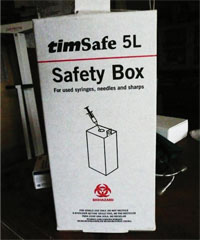23.3.5 Use of safety boxes
You should always collect sharp wastes immediately after use in a safety box. This helps you avoid injuries.

A safety box is used only for sharps (Figure 23.1). It is designed as a puncture- and leak-resistant container for their collection and disposal. The advantage is it confines all sharps in one place and helps prevent reuse. The correct use of safety boxes can prevent needlestick injuries to you and the community. The role of health workers (you) and waste handlers in proper use of safety boxes, starting from assembly through to final disposal, is critical. You should follow these guidelines for effective use of safety boxes:
- Follow the instructions printed on the box.
- Keep safety boxes within your reach at each place where you give injections.
- Dispose of the used syringes into the safety box immediately after use.
- Do not recap and do not collect syringes for future disposal.
- Never place fingers inside the box.
- Stop using the box and close the flap (cover) when it reaches three-quarters full; do not overfill.
- When handling the safety box, always wear gloves.
- Once a safety box contains any sharps, it should be stored in a locked room or cupboard to prevent the public from coming into contact with it.
- Finally, do not forget to wash your hands using antiseptic or hand rub and dry them after using the safety box.
- When the safety box is three-quarters full it should be incinerated (see Section 23.4.2 for further details) and the remains disposed of in a sharps pit (see Section 23.4.4).
23.3.4 Recycling and reuse of healthcare waste
